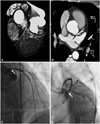Abstract
Although atherosclerotic obstruction is the main cause of left main coronary artery (LMCA) disease, it can also be associated with vasospasm. We report a case of a 61-year-old male who presented with ostial stenosis of the LMCA, detected by 64-slice multi-detector computed tomographic coronary angiography (MDCT-CA). Careful review of MDCT and intravascular ultrasound findings showed suspicion of an isolated spasm of the LMCA without a significant atherosclerotic lesion. The patient was successfully treated with nitrates and a calcium channel blocker.
Vasospasm of the left main coronary artery (LMCA) is a very rare, sometimes life-threatening cardiovascular event,1)2) which may be caused by spontaneous simultaneous coronary spasm (as with variant angina in an uncommon case) or caused by an iatrogenic (catheter- or guidewire-induced) component. Although catheter-induced spasm of the LMCA has been documented,3) routine diagnostic catheterization rarely causes LMCA spasm.4) We report a case of spontaneous spasm of the LMCA detected by 64-slice multi-detector computed tomographic coronary angiography (MDCT-CA).
A 61-year-old male was sent to undergo coronary angiography for suspected angina from significant ostial stenosis of the LMCA found on MDCT (Fig. 1A and B). He had suffered from frequent morning chest tightness that occurred at rest during the past 2 months. He had no risk factors for coronary artery disease and did not smoke or drink alcohol. Routine laboratory findings, including a thyroid function test, were within normal limits. Significant narrowing of the LMCA compatible with the MDCT finding was detected on coronary angiography (Fig. 1C). We conducted an intravascular ultrasound (IVUS) to confirm the coronary angiographic findings after intracoronary administration of 200 µg nitroglycerine. IVUS results showed negative remodeling of the LMCA without significant atherosclerotic change (Fig. 2A). After additional administration of 500 µg nitroglycerine, we again performed coronary angiography (Fig. 1D) and IVUS (Fig. 2B), which showed a dilated LMCA without negative remodeling. Under the suspicion of having an isolated LMCA spasm, this patient was discharged with nitrates and a calcium channel blocker; he did not complain of any chest discomfort during the follow-up period.
A spontaneous spasm of the LMCA is very unusual.4) If there are no images available on MDCT, it may first be considered as a case of catheter-induced spasm. In this case report, MDCT ruled out catheter-induced coronary spasm as the underlying reason for the isolated LMCA stenosis seen on coronary angiography. In this case, IVUS and its findings also helped in eliminating any unnecessary interventions. In addition, recent data has demonstrated that elective stenting with IVUS guidance may reduce the long-term mortality rate for unprotected LMCA stenosis when compared to stenting with conventional angiography guidance.5) Therefore, IVUS guidance can be very useful, not only in optimization of procedures, but also in the avoidance of interventions for non-atherosclerotic obstructive lesions.
Although a spontaneous LMCA spasm may result in consequences as serious as myocardial infarction or cardiogenic shock,2) this patient suffered from morning chest discomfort, which was easily controlled with medical treatment. He denied alcohol consumption and smoking, which are well-known precipitating factors for coronary spam.6)7) Due to the fact that dominant spasms of the MDCA without precipitating risk factors might be encountered in relatively stable subjects, MDCT and IVUS findings may assist to differentiate these cases from atherosclerotic or catheter-induced narrowing of the LMCA.
Figures and Tables
 | Fig. 1MDCT showed >50% ostial stenosis of the LMCA (A and B). Coronary angiography demonstrated significant narrowing of the LMCA before infusion of nitroglycerine (C) and adequate dilation of the LMCA after infusion of nitroglycerine (D). MDCT: multi-detector computed tomography, LMCA: left main coronary artery. |
 | Fig. 2IVUS imaging after intracoronary administration of 200 µg nitroglycerine showed persistent negative remodeling of the LMCA without significant atherosclerotic change (A). After additional administration of 500 µg nitroglycerin, a dilated LMCA without evidence of negative remodeling was noted (B). IVUS: intravascular ultrasound, LMCA: left main coronary artery. |
References
1. Yasue H, Nakagawa H, Itoh T, Harada E, Mizuno Y. Coronary arteryspasm: clinical features, diagnosis, pathogenesis, and treatment. J Cardiol. 2008. 51:2–17.
2. Chuang YT, Ueng KC. Spontaneous and simultaneous multivessel coronary spasm causing multisite myocardial infarction, cardiogenic shock, atrioventricular block, and ventricular fibrillation. Circ J. 2009. 73:1961–1964.
3. Parakh N, Singh S, Math RS, Sharma S, Bahl VK. Catheter-induced left main coronary artery spasm. J Cardiovasc Med (Hagerstown). 2009. 10:288–289.
4. Pflederer T, Marwan M, Ropers D, Daniel WG, Achenbach S. CT angiography unmasking catheter-induced spasm as a reason for left main coronary artery stenosis. J Cardiovasc Comput Tomogr. 2008. 2:406–407.
5. Park SJ, Kim YH, Park DW, et al. Impact of intravascular ultrasound guidance on long-term mortality in stenting for unprotected left main coronary artery stenosis. Circ Cardiovasc Interv. 2009. 2:167–177.
6. Yoo SY, Kim JY. Recent insights into the mechanisms of vasospastic angina. Korean Circ J. 2009. 39:505–511.
7. Lee KH, Lee H, Bae MH, et al. Gender differences among Korean patients with coronary spasm. Korean Circ J. 2009. 39:423–427.




 PDF
PDF ePub
ePub Citation
Citation Print
Print


 XML Download
XML Download